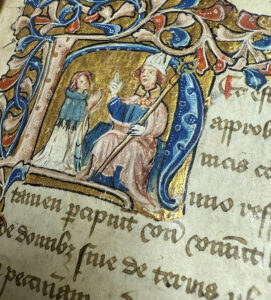 By Emma Laws, Cathedral Librarian
By Emma Laws, Cathedral Librarian
Medieval scribes and artists often decorated the initial letters at the beginning of paragraphs or sections of text. These initials are usually larger and variously decorated; some are coloured red, blue or green while others intertwine with foliage or real and imaginary animals, such as snails, lions, birds and dragons. Historiated initials tell stories using recognisable figures. This initial features a seated bishop; he wears a blue cassock under a pink cope – a long cloak open at the front and fastened with an ornate clasp called a morse. We can be sure the figure is a bishop – he wears the bishop’s mitre on his head and carries a crozier in his left hand. The other figure is a canon wearing a white surplice and blue tasselled almuce or shoulder cape; he kneels before the bishop to receive a blessing.
We can’t be certain which bishop is depicted here but the initial is from a late 14th century manuscript of ordinances and statutes of Exeter Cathedral which includes a chronicle of the city of Exeter from the beginning of time to 1394. Bishop Thomas Brantyngham served from 1370 until his death in 1394 so perhaps the artist is commemorating his death with a portrait. Or the initial may simply be a representation of the role of bishop. Either way, the artist would have begun with an outline in lead, then applied the gold leaf and burnished it to a high shine, then added the delicate colours and, finally, outlined the details in black – a beautiful work of art in miniature.